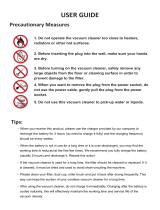
d) Always lead the supply cord, the extension cord
and the suction hose away to the rear when work-
ing. This will help to prevent tripping while working.
e) After finishing the work, always tidy up and stow
the supply cord, extension cord and suction hose
away securely. This will reduce the risk of tripping
and falling.
f) Do not transport the appliance by crane.
g) Children must be instructed not to play with the
appliance.
h) This appliance is not intended for use by per-
sons (including children) with reduced physical,
sensory or mental capabilities, or lack of experi-
ence and knowledge, unless they have been given
supervision or instruction concerning use of the
appliance by a person responsible for their safety.
5.2.4 Use and care of the appliance
a) Never leave the appliance unattended.
b) Protect the appliance from frost.
c) With vacuum cleaners of the class M, take care
to ensure that the hose socket cap is fitted when
the appliance is transported or not in use.
d) Check that the filter is seated correctly. Check to
ensure that the filter is undamaged.
e) Do not pull the wheels of the vacuum cleaner over
the supply cord.
f) The water level limiting device must be cleaned
regularly with a brush in accordance with instruc-
tions and checked for signs of damage.
g) Recharge only with the charger specified by the
manufacturer. A charger that is suitable for one
type of battery pack may create a risk of fire when
used with another battery pack.
h) When battery pack is not in use, keep it away
from other metal objects, like paper clips, coins,
keys, nails, screws or other small metal objects,
that can make a connection from one terminal to
another. Shorting the battery terminals together may
cause burns or a fire.
i) Under abusive conditions, liquid may be ejected
from the battery; avoid contact. If contact acci-
dentally occurs, flush with water. If liquid contacts
eyes, additionally seek medical help. Liquid ejec-
ted from the battery may cause irritation or burns.
j) Do not expose batteries to high temperatures or
fire. This presents a risk of explosion.
k) Do not disassemble, squash or incinerate batter-
ies and do not subject them to temperatures over
80°C. This presents a risk of fire, explosion or injury
through contact with caustic substances.
l) Avoid ingress of dampness.Dampness may cause
a short circuit resulting in a risk of burning injury or
fire.
m) Do not use batteries other than those approved
for use with the applicable tool or appliance. Use
of other batteries or use of the battery for purposes
for which it is not intended presents a risk of fire and
explosion.
n) Observe the special instructions applicable to the
transport, storage and use of Li-ion batteries.
o) Avoid short-circuiting the battery.Before inserting
the battery in the tool or appliance, check that the
terminals of the battery and the tool or appliance are
free from foreign objects. Short-circuiting the battery
terminals presents a risk of fire, explosion or contact
with caustic substances.
p) Do not charge or continue to use damaged bat-
teries (e.g. batteries with cracks, broken parts,
bent or pushed-in and/or pulled-out contacts).
5.2.5 Mechanical
Follow the instructions concerning care and mainten-
ance.
5.2.6 Electrical
a) Insert the plug in a suitable earthed/grounded
power outlet which has been correctly and safely
installed and is in compliance with local regula-
tions.
b) If you are in doubt about the effectiveness of the
power outlet’s earth/ground connection, have it
checked by a qualified specialist.
c) Check the appliance’s supply cord at regular in-
tervals and have it replaced at a Hilti service
center if damage is found. Check extension cords
at regular intervals and replace them if found to
be damaged.
d) Check the condition of the appliance and its ac-
cessories. Do not operate the appliance and its
accessories if damage is found, if the appliance is
incomplete or if its controls cannot be operated
faultlessly.
e) Do not touch the supply cord or extension cord if
they are damaged while working. Disconnect the
supply cord plug from the power outlet. Damaged
supply cords present a risk of electric shock.
f) The electric supply cord may be replaced only
with a cord of the type specified in the operating
instructions.
g) In case of an interruption in the electric supply:
Switch the appliance off and unplug the supply
cord.
h) Avoid using extension cords with multiple power
outlets and the simultaneous use of several ap-
pliances connected to one extension cord.
i) Use the electric tool power outlet only for the
purposes described in the operating instructions.
j) Never spray the top section of the vacuum cleaner
with water: this presents an electrical hazard and
may damage the appliance.
k) Connectors on mains power cables, extension
cords or supply cords must provide protection
from sprayed water.
l) Grip the plug when unplugging the supply cord
(do not pull or tug at the supply cord).
en
27
Printed: 24.03.2014 | Doc-Nr: PUB / 5140206 / 000 / 03




















